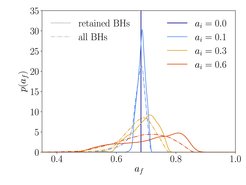Towards a deeper understanding of black hole origins
Research team studies the impact of remnant kicks on spin distributions of black holes from hierarchical mergers
When gravitational-wave detectors observe signals from binary black hole mergers, not all of the black holes may necessarily be the immediate product of a supernova explosion. Some may have formed through repeated binary mergers in dense stellar environments, such as globular clusters. Inferring the spins and masses of black holes through their imprints on gravitational-wave signals is one way to probe their past and origin. This requires an accurate understanding and modelling of the spin and mass distributions from different formation channels. Previous studies have shown that the spin distribution is unique and roughly independent of the mass distribution, spins at birth, and merger generation. A new study revisits this topic and includes a new key ingredient: the remnant kicks produced in these mergers. These kicks are caused by gravitational waves carrying away linear momentum from the binary, and can reach velocities of up to 5000 km/s, often ejecting black holes from their host environments. This means, only those that remain in the cluster will undergo further mergers. Because the kick velocity depends on the mass ratio of the binary and the individual spins, some binaries are more likely to be retained than others and therefore, certain remnant spin magnitudes are more likely after repeated mergers. The study finds clear deviations from the unique spin distribution described in previous studies, and shows a way to identify black holes from repeated mergers, which could help shed light on black hole formation through precise spin measurements in future observing runs.
Paper abstract
One proposed black hole formation channel involves hierarchical mergers, where black holes form through repeated binary mergers. Previous studies have shown that such black holes follow a near-universal spin distribution centered around 0.7. However, gravitational-wave kicks can eject remnants from their host environments, meaning only retained black holes can participate in subsequent mergers. We calculate the spin distribution of retained black holes in typical globular clusters, accounting for remnant kick velocities. Since the kick magnitude depends on the binary’s mass ratio and spin orientations, certain configurations are more likely to be retained than others. This preferentially selects certain remnant spin magnitudes, skewing the spin distribution of second-generation black holes away from the universal distribution. In low escape velocity environments, the distribution can become bimodal, as remnants with spins of 0.7 typically receive larger kicks than other configurations. Regarding higher-generation black holes, their spin distribution does not converge to a unique form, and can span a broad range of spins, af ∈ (0.4, 1), depending on their merger history, birth spins and the escape velocity. Additionally, we find that the presence of a small fraction of binaries with near-aligned spins can produce a second, more dominant peak, whose position depends on the birth spin magnitude. Our findings identify observable features of hierarchical merger black holes, which is essential for understanding their contribution to the gravitational-wave population. Moreover, the dependence of the spin distribution on astrophysical parameters means that precise spin measurements could provide insights into their formation environments.













